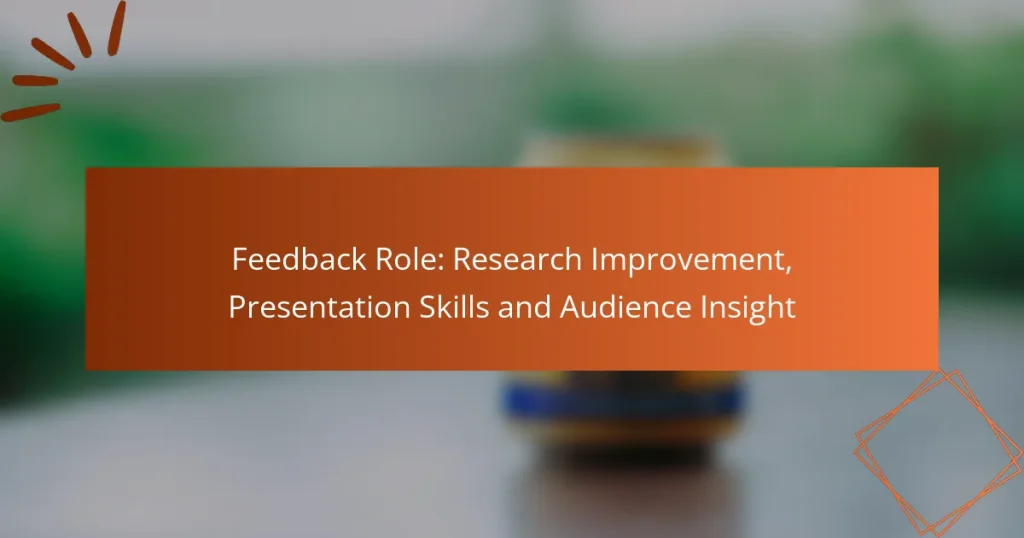Feedback plays a crucial role in improving research quality by highlighting weaknesses and guiding enhancements. Effective presentation skills, such as clear communication and active listening, ensure that feedback is both understood and valued by the audience. Additionally, tailoring feedback to the specific needs of the audience enhances its relevance and impact, fostering a more productive dialogue.
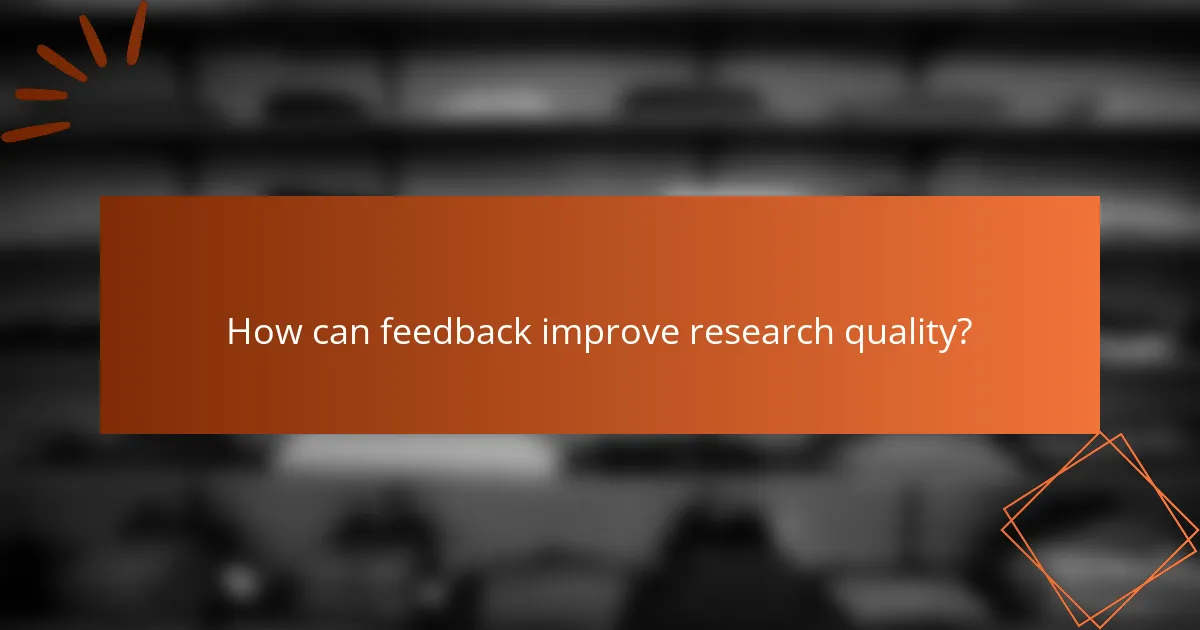
How can feedback improve research quality?
Feedback is essential for enhancing research quality as it provides insights that can identify weaknesses and areas for improvement. By incorporating constructive criticism, researchers can refine their work, leading to more robust and credible outcomes.
Identifying gaps in data
Feedback helps researchers pinpoint gaps in their data collection and analysis. External reviewers can highlight areas where additional data is needed or where existing data may be insufficient to support conclusions.
For instance, if a study on consumer behavior lacks demographic diversity, feedback can prompt researchers to include a broader range of participants, enhancing the study’s relevance and applicability.
Enhancing methodology
Constructive feedback can significantly improve research methodology by suggesting alternative approaches or techniques. Reviewers may recommend more rigorous statistical analyses or different data collection methods that could yield more accurate results.
For example, if a researcher uses surveys to gather data, feedback might suggest incorporating qualitative interviews to gain deeper insights, thus enriching the overall findings.
Increasing reliability of findings
Feedback contributes to the reliability of research findings by encouraging peer review and validation of results. When researchers receive critiques, they can address potential biases or errors, leading to more trustworthy conclusions.
To enhance reliability, researchers should consider implementing a feedback loop where they regularly seek input from colleagues throughout the research process, not just at the end. This ongoing dialogue can help catch issues early and improve the overall integrity of the research.
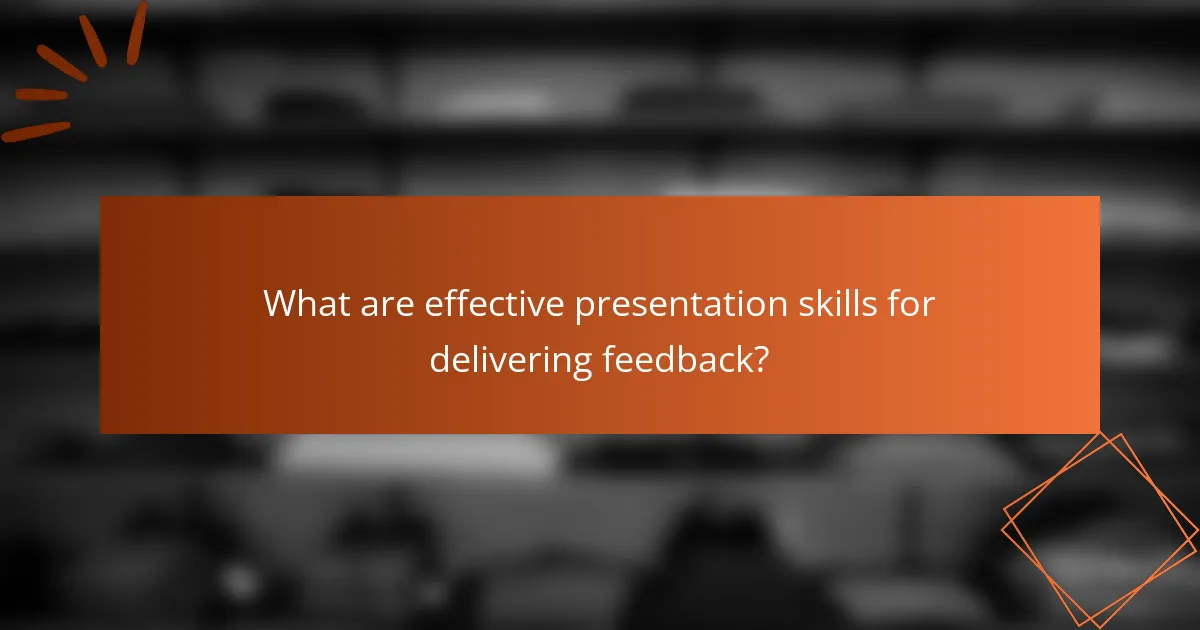
What are effective presentation skills for delivering feedback?
Effective presentation skills for delivering feedback include clear communication, engaging storytelling, and active listening. These skills help ensure that feedback is not only understood but also appreciated and acted upon by the audience.
Engaging storytelling techniques
Utilizing storytelling techniques can make feedback more relatable and memorable. Start with a relevant anecdote or scenario that illustrates the main point, allowing the audience to connect emotionally with the message.
Consider structuring your story with a clear beginning, middle, and end. This approach helps maintain the audience’s interest and emphasizes the feedback’s significance. For instance, sharing a personal experience where feedback led to improvement can inspire others to embrace constructive criticism.
Using visual aids effectively
Visual aids enhance understanding and retention of feedback. Use slides, charts, or infographics to present data clearly and concisely. Aim for simplicity; avoid cluttered visuals that can distract from your message.
When using visual aids, ensure they complement your spoken words. For example, if discussing performance metrics, display a simple graph that highlights key trends. This combination reinforces your points and helps the audience grasp complex information quickly.
Practicing active listening
Active listening is crucial when delivering feedback, as it fosters a two-way dialogue. Show genuine interest in the audience’s responses by maintaining eye contact, nodding, and paraphrasing their comments to confirm understanding.
Encourage questions and clarifications to ensure that your feedback is clear. This approach not only demonstrates respect for the audience’s perspectives but also allows for a more productive discussion. Avoid interrupting and give ample time for responses to create a supportive environment.
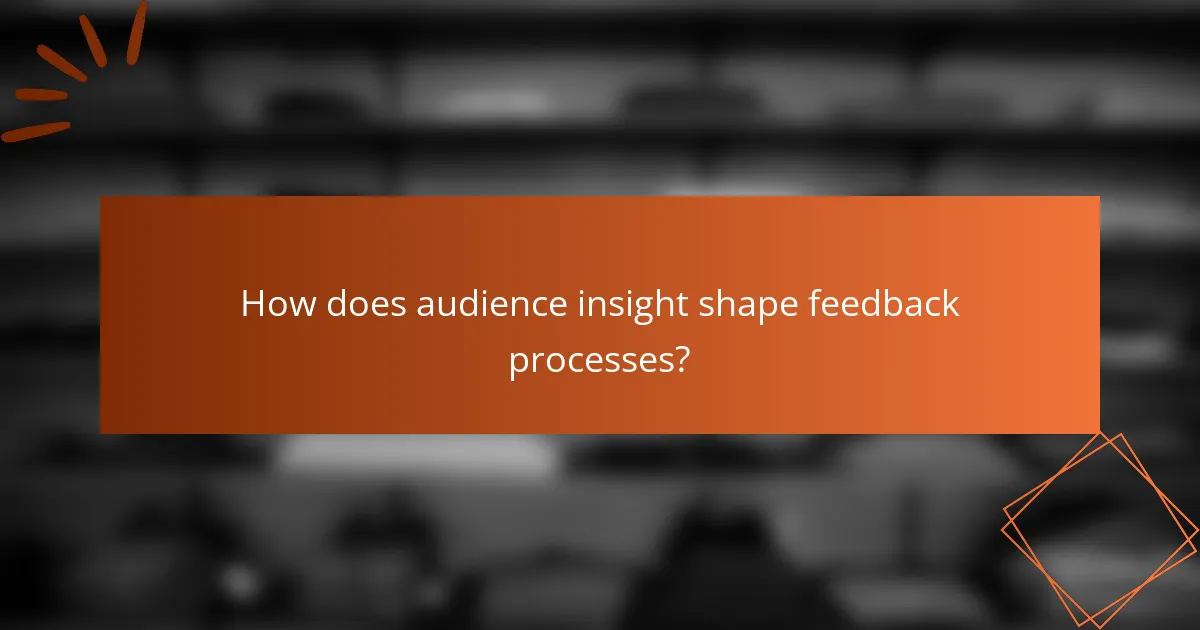
How does audience insight shape feedback processes?
Audience insight significantly influences feedback processes by ensuring that the feedback is relevant and tailored to the specific needs and preferences of the audience. Understanding who the audience is allows for more effective communication and enhances the overall impact of the feedback provided.
Understanding audience demographics
Recognizing audience demographics involves analyzing characteristics such as age, gender, education level, and cultural background. This information helps in tailoring messages that resonate with the audience’s experiences and expectations. For instance, a presentation aimed at young professionals may use contemporary references and a casual tone, while one for senior executives might adopt a more formal approach.
Demographic insights can also inform the choice of communication channels. Younger audiences may prefer digital platforms like social media or webinars, whereas older demographics might respond better to traditional methods like in-person meetings or printed materials.
Adapting content to audience needs
Adapting content to audience needs requires a clear understanding of their interests and pain points. Feedback should address specific challenges the audience faces, providing actionable solutions that they can implement. For example, if a survey reveals that an audience struggles with time management, feedback could include tips on prioritizing tasks effectively.
It’s essential to avoid jargon or overly technical language unless the audience is familiar with such terms. Instead, use simple, relatable language that encourages engagement and understanding. Regularly soliciting feedback from the audience can also help refine content and ensure it remains relevant to their evolving needs.
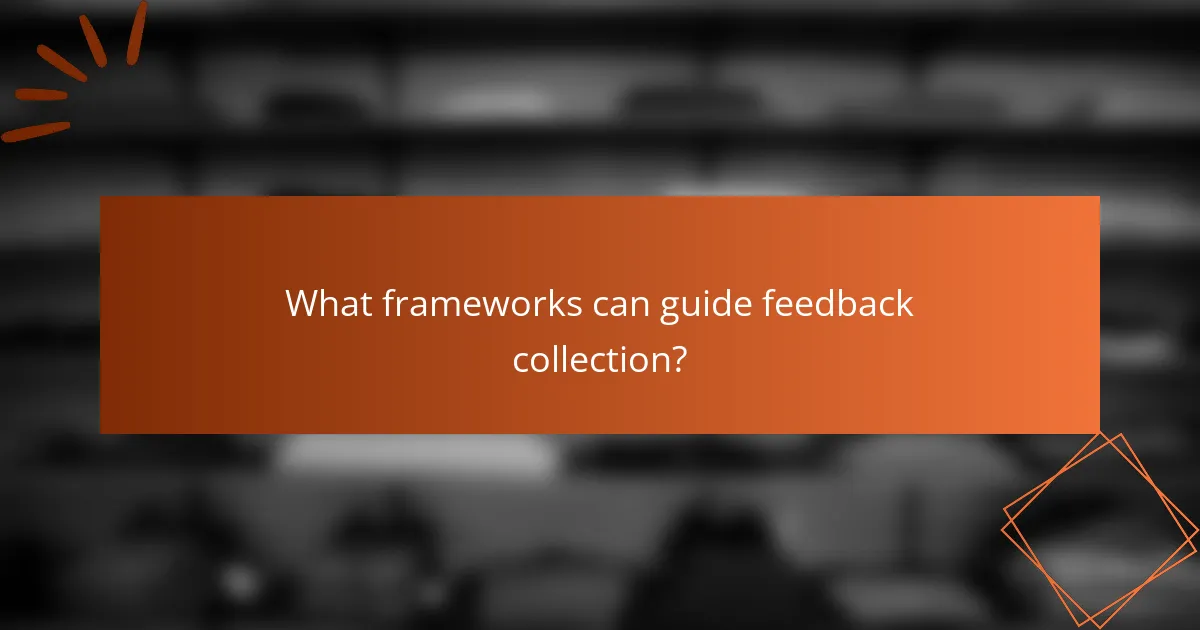
What frameworks can guide feedback collection?
Several frameworks can effectively guide feedback collection, including structured feedback loops and peer review processes. These frameworks help ensure that feedback is systematic, actionable, and relevant to the research or presentation context.
Feedback loops in research
Feedback loops in research involve continuous cycles of input, evaluation, and adjustment. Researchers can implement these loops by regularly soliciting input from peers, mentors, or target audiences at various stages of their work.
For example, conducting interim presentations or sharing draft findings can provide opportunities for real-time feedback. This iterative process allows researchers to refine their work based on constructive criticism, ultimately enhancing the quality of their final output.
To establish effective feedback loops, consider setting specific intervals for feedback collection and clearly communicating expectations to participants. Avoid pitfalls such as vague questions that may lead to unhelpful responses.
Peer review processes
Peer review processes are formal mechanisms where experts evaluate research before publication or presentation. This framework ensures that the work meets established standards and is free from significant errors or biases.
Typically, peer review involves multiple reviewers who provide insights on methodology, findings, and overall clarity. For instance, academic journals often require peer-reviewed submissions, which can take several weeks to months, depending on the field and journal policies.
To navigate peer review successfully, researchers should choose appropriate reviewers with relevant expertise and be open to constructive criticism. It’s crucial to address feedback thoroughly and make necessary revisions to improve the work’s credibility and impact.
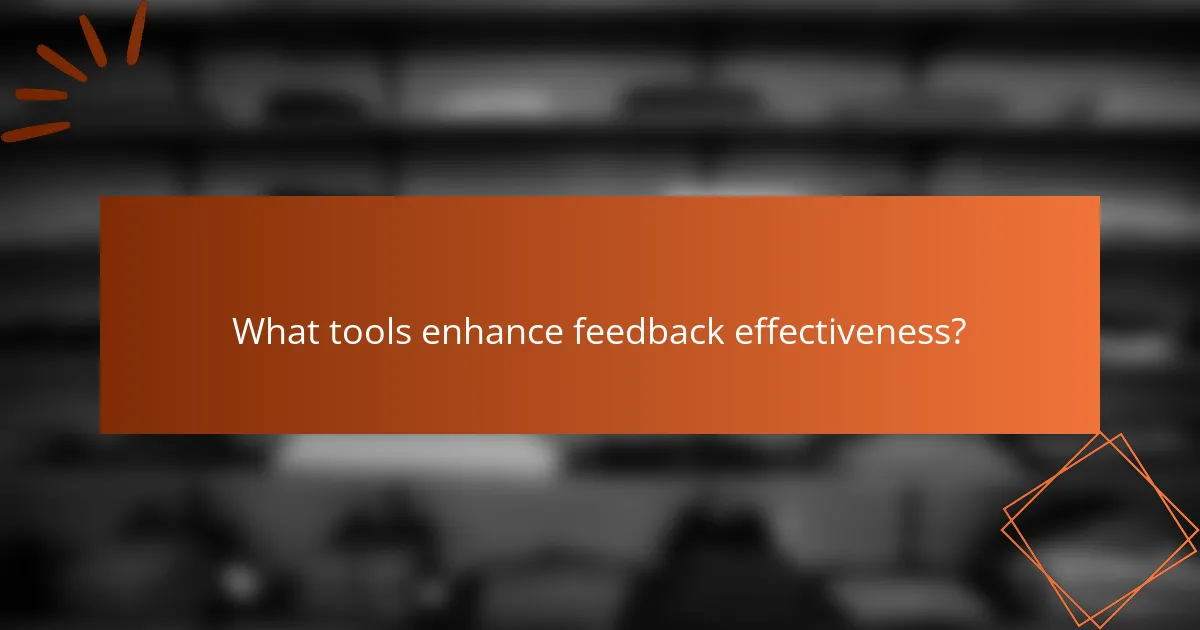
What tools enhance feedback effectiveness?
Effective feedback can be significantly enhanced using various tools designed for gathering insights and facilitating communication. These tools streamline the process of collecting, analyzing, and responding to feedback, ultimately improving presentation skills and audience engagement.
SurveyMonkey for surveys
SurveyMonkey is a popular platform for creating and distributing surveys that gather feedback efficiently. Users can design custom surveys with various question types, making it easy to tailor inquiries to specific audiences.
When using SurveyMonkey, consider the length and clarity of your questions to maximize response rates. Aim for surveys that take no longer than 5-10 minutes to complete, as shorter surveys generally yield higher participation.
Google Forms for data collection
Google Forms is an accessible tool for collecting feedback and data from participants. It allows users to create forms that can be shared via links, making it easy to reach a wide audience.
Utilize Google Forms’ features like multiple-choice questions and rating scales to gather structured feedback. Ensure that your forms are visually appealing and straightforward, which can help improve completion rates.
Slack for real-time communication
Slack is an effective platform for real-time communication and feedback exchange among team members. It enables instant messaging, file sharing, and the creation of dedicated channels for specific topics, facilitating ongoing discussions.
To enhance feedback effectiveness on Slack, encourage team members to share their thoughts openly and respond promptly to inquiries. Establishing a culture of open communication can lead to more insightful feedback and improved collaboration.
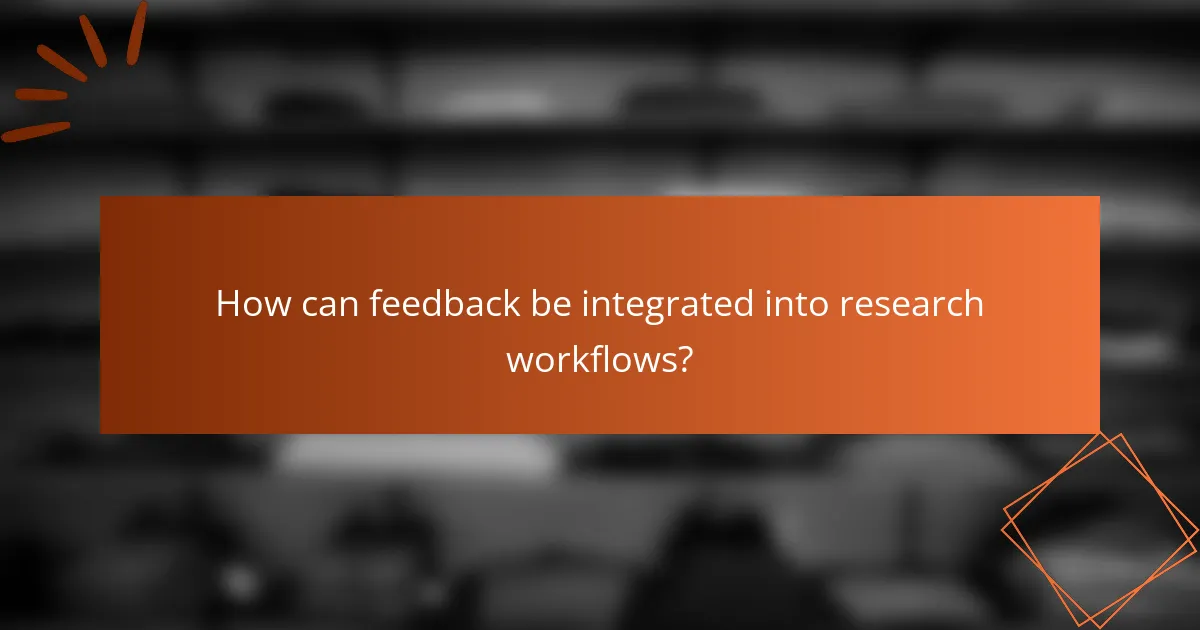
How can feedback be integrated into research workflows?
Integrating feedback into research workflows enhances the quality and relevance of findings. By systematically incorporating input from peers and stakeholders, researchers can refine their work and better align it with audience needs.
Regular feedback sessions
Regular feedback sessions are essential for maintaining an iterative research process. These sessions can be scheduled weekly or bi-weekly, allowing researchers to present their progress and receive constructive criticism. This consistent engagement helps identify issues early and fosters a collaborative environment.
During feedback sessions, researchers should prepare specific questions or topics for discussion to guide the conversation. This focus can lead to more actionable insights and reduce the time spent on general comments. For example, asking for input on a particular methodology can yield targeted suggestions that enhance the research design.
To maximize the effectiveness of feedback sessions, consider establishing ground rules that promote respectful and constructive dialogue. Encourage participants to provide both positive feedback and areas for improvement, ensuring a balanced approach that motivates researchers while also driving quality enhancements.
